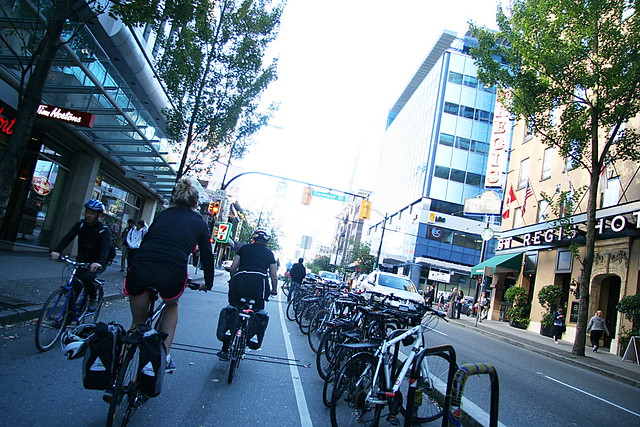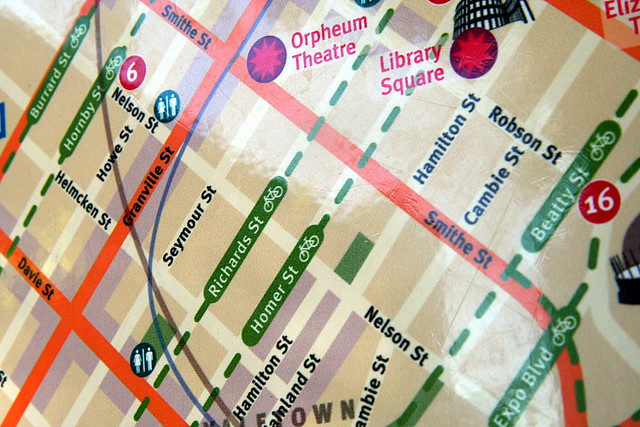Three years ago, I got back from a trip to ride Vancouver BC’s new downtown protected bike lane network and promised every BikePortland reader a Japadog if our northern neighbor didn’t see a “substantial increase” in biking over the following three years.
I’m relieved to inform all of you who read that post that I was right.
Less exciting is the fact that the long-funded downtown Portland protected bike lane network that led me to title that 2013 post “A preview of Portland?” has yet to even start its public outreach process here in the south.
In any case, an amazing slideshow of survey results presented to the Vancouver City Council on Wednesday are a rock-solid reminder that good bike infrastructure can have a spectacular payoff, even in a city that already has quite a bit of biking.
According to Vancouver’s annual transportation panel surveys, bike commuting is up to 10 percent of the resident working population as of 2015:
Vancouver’s 2014 bike-commuting estimate was 9 percent, up from 4 percent in 2011. According to the U.S. Census, Portland’s bike-commuting rate in 2014 was 7 percent.
There are a few technical apples-to-oranges type reasons that it’s not certain whether Vancouver’s bike-commuting rate is higher than Portland’s. But as we’ve written before, citywide bike-commuting rates aren’t actually very good at comparing cities with one another, because they depend so much on where the city limits happen to fall.
However, statistics like these are good at showing how cities change over time. And the pace of changes in Vancouverites’ transportation have been extraordinary.
The Vancouver metro area has almost exactly the same population as Portland’s, 2.3 million. Like Portland, it spent much of the 20th century as a working-class port city and then began to see rapid job growth and migration with the urban economic boom that began around 1990.
As in Portland, that’s led to a prosperous economy compared to other North American cities but also to a deep and costly housing shortage.
So what has Vancouver been doing differently on transportation over the last few years, enabling it to add tens of thousands of new commutes but hardly any additional auto trips?
“If we want to get to the 10- or 20-percent mark, we’re going to need facilities.”
— Rob Wynen, Vancouver bicycle advisory committee, 2010
Among other things, it’s been taking heat.
Starting in 2010, soon after electing Mayor Gregor Robertson, the city began lacing a grid of protected bike lanes through its very dense downtown, displacing parking and passing lanes in an effort to open up a central city that was described as “the Bermuda triangle for cyclists.”
As of 2011, citywide biking rates were at approximately 4 percent — well below Portland, which hit 6 percent in 2008 and then plateaued.
“If we want to get to the 10- or 20-per-cent mark, we’re going to need facilities,” said Rob Wynen, vice chair of the city’s bicycle advisory committee.
The Downtown Vancouver Business Improvement Association was upset, warning that removing parking would kill business downtown.
“Some parts of our downtown are well serviced by off-street parking, but others aren’t, and losing even a little in the street has an impact,” said Charles Gauthier, DVBIA’s director.
Others disagreed.
“What I object to is the assumption that removing parking and putting in a cycle track is bad for business,” said Gordon Price, a former city councilor. “I’ve got studies which indicate it isn’t. What do you have?”
Price and his allies won the argument. By the time I visited in 2013, they’d built arguably the best connected downtown protected bike lane network in North America.
Then Vancouver kept going. In summer 2013 the council took a difficult vote, in the face of intense criticism from residents of a wealthy seaside neighborhood, to use traffic diverters to convert a busy arterial called Point Grey Road into a residential street and all-ages bikeway.
“Do we feel like this is going a bit too fast?” asked Duane Nickull, a former bicycle racer who lived in the Point Grey area and led opposition to the bikeway.
Advertisement
But Vancouver’s council voted for the change anyway, creating a spectacular, continuous new “Seaside Greenway” along English Bay and across the Burrard Bridge into the new downtown biking network.
Here’s what happened next:
And along the way, another funny thing happened: the downtown business association completely changed its tune.
“It’s obvious that separated bike lanes [are] working in the downtown area.”
— Charles Gauthier, Downtown Vancouver Business Improvement Association, 2015
“It’s obvious that separated bike lanes [are] working in the downtown area and I don’t think any politician, regardless of what political party they’re with, would ever dare take them out,” Gauthier told a local radio station last May. “We’re seeing obviously a greater demographic of people of all ages and abilities in the separated bike lanes because they’re obviously more safe and providing more comfort. At the end of the day, we don’t want to tell employers that we’re not accommodating maybe a portion of their employees that are coming to work by bike, nor do we want to turn away customers that are making that decision.”
Steve Da Cruz, owner of The Parker restaurant just east of downtown, had loudly objected to removing parking spaces on his street to add a bike lane in 2013. By 2014, he was telling the media that business had actually gone up.
“We definitely have benefited from the increased usage of the bike lane,” Da Cruz told the local business journal.
As for Mayor Robertson, who has made biking a core part of his political identity, he was handily re-elected to his third term in 2014.
Does this mean that every protected bike lane project will boost retail sales? No, of course not. But Vancouver’s success in rapidly boosting biking to a rate we’ve probably never seen in a major modern North American city is an encouraging sign of the payoff that could be possible in Portland after just a few years’ worth of political courage.
Thanks to the Vancouver Sun for reporting the data.
— Michael Andersen, (503) 333-7824 – michael@bikeportland.org
Our work is supported by subscribers. Please become one today.










